BSBWOR502 Lead and Manage Team Effectiveness - Full Assessment
VerifiedAdded on 2024/06/28
|49
|10835
|425
Homework Assignment
AI Summary
This document provides a comprehensive assessment solution for BSBWOR502 Lead and Manage Team Effectiveness. It includes answers to written questions covering key elements of a team charter, the role of standard operating procedures, positive coaching, and constructive versus destructive feedback. The solution also addresses a holistic assessment task and a case study, focusing on performance elements related to team management. The assessments cover topics such as team purpose, objectives, stakeholder management, decision-making rules, and team norms. The document emphasizes the importance of positive coaching for team and individual development, as well as the difference between constructive and destructive feedback. The assessment solution is designed to evaluate a student's understanding and application of effective team leadership and management principles.
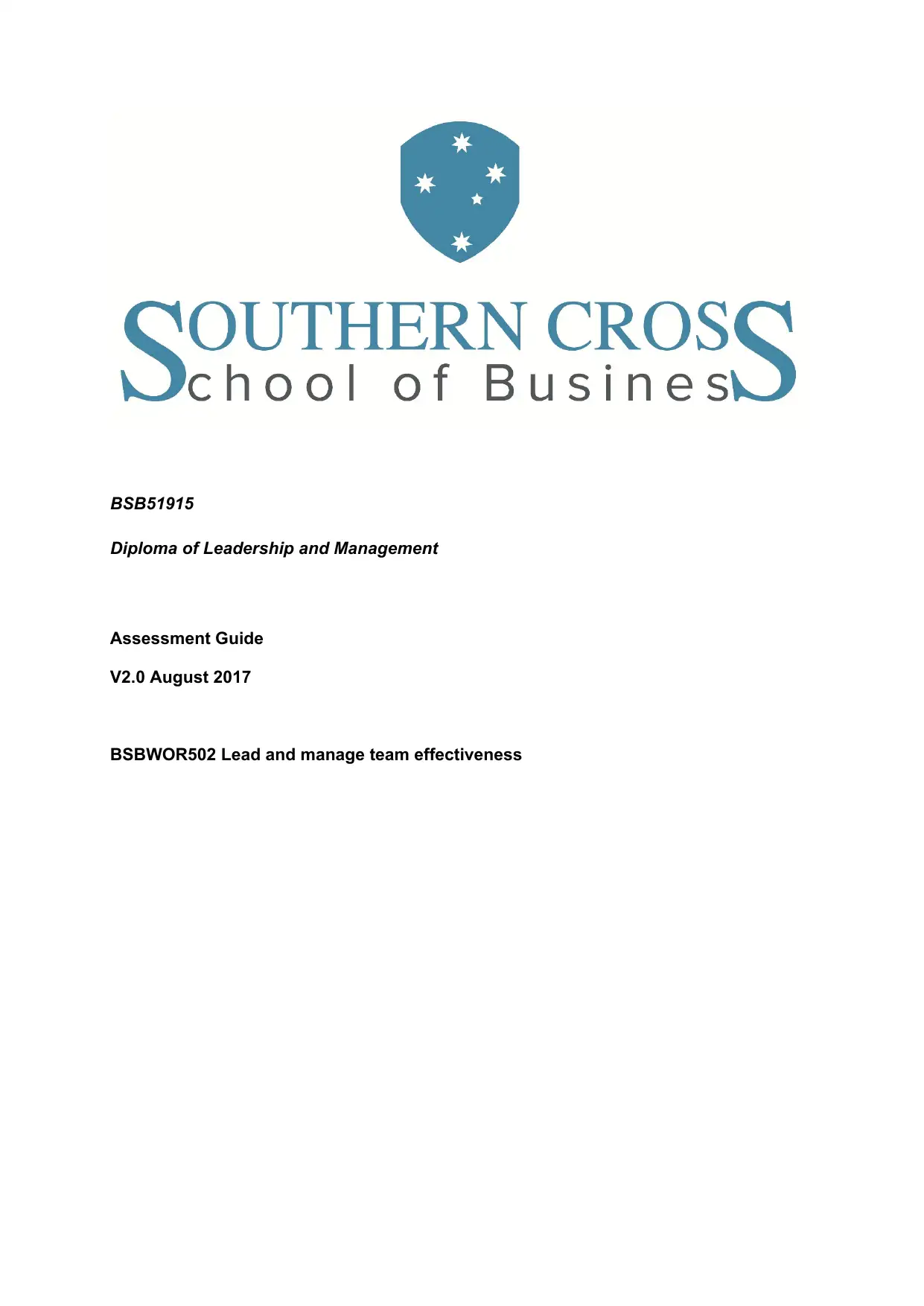
BSB51915
Diploma of Leadership and Management
Assessment Guide
V2.0 August 2017
BSBWOR502 Lead and manage team effectiveness
Diploma of Leadership and Management
Assessment Guide
V2.0 August 2017
BSBWOR502 Lead and manage team effectiveness
Paraphrase This Document
Need a fresh take? Get an instant paraphrase of this document with our AI Paraphraser
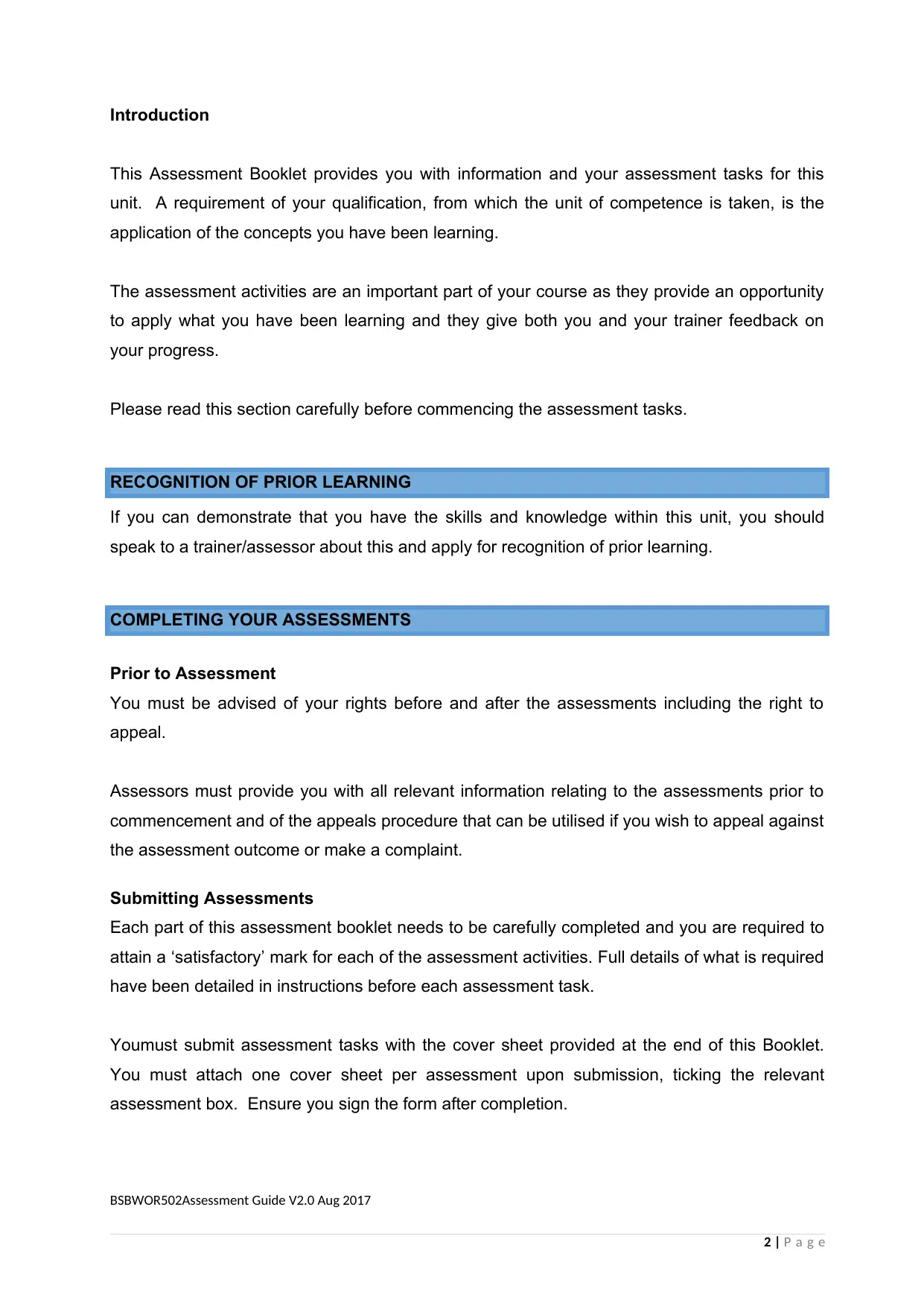
Introduction
This Assessment Booklet provides you with information and your assessment tasks for this
unit. A requirement of your qualification, from which the unit of competence is taken, is the
application of the concepts you have been learning.
The assessment activities are an important part of your course as they provide an opportunity
to apply what you have been learning and they give both you and your trainer feedback on
your progress.
Please read this section carefully before commencing the assessment tasks.
RECOGNITION OF PRIOR LEARNING
If you can demonstrate that you have the skills and knowledge within this unit, you should
speak to a trainer/assessor about this and apply for recognition of prior learning.
COMPLETING YOUR ASSESSMENTS
Prior to Assessment
You must be advised of your rights before and after the assessments including the right to
appeal.
Assessors must provide you with all relevant information relating to the assessments prior to
commencement and of the appeals procedure that can be utilised if you wish to appeal against
the assessment outcome or make a complaint.
Submitting Assessments
Each part of this assessment booklet needs to be carefully completed and you are required to
attain a ‘satisfactory’ mark for each of the assessment activities. Full details of what is required
have been detailed in instructions before each assessment task.
Youmust submit assessment tasks with the cover sheet provided at the end of this Booklet.
You must attach one cover sheet per assessment upon submission, ticking the relevant
assessment box. Ensure you sign the form after completion.
BSBWOR502Assessment Guide V2.0 Aug 2017
2 | P a g e
This Assessment Booklet provides you with information and your assessment tasks for this
unit. A requirement of your qualification, from which the unit of competence is taken, is the
application of the concepts you have been learning.
The assessment activities are an important part of your course as they provide an opportunity
to apply what you have been learning and they give both you and your trainer feedback on
your progress.
Please read this section carefully before commencing the assessment tasks.
RECOGNITION OF PRIOR LEARNING
If you can demonstrate that you have the skills and knowledge within this unit, you should
speak to a trainer/assessor about this and apply for recognition of prior learning.
COMPLETING YOUR ASSESSMENTS
Prior to Assessment
You must be advised of your rights before and after the assessments including the right to
appeal.
Assessors must provide you with all relevant information relating to the assessments prior to
commencement and of the appeals procedure that can be utilised if you wish to appeal against
the assessment outcome or make a complaint.
Submitting Assessments
Each part of this assessment booklet needs to be carefully completed and you are required to
attain a ‘satisfactory’ mark for each of the assessment activities. Full details of what is required
have been detailed in instructions before each assessment task.
Youmust submit assessment tasks with the cover sheet provided at the end of this Booklet.
You must attach one cover sheet per assessment upon submission, ticking the relevant
assessment box. Ensure you sign the form after completion.
BSBWOR502Assessment Guide V2.0 Aug 2017
2 | P a g e

Assessments should be submitted on or before their due date. Extensions for individual
assessment tasks may be negotiated in specific circumstances. Consultation on this must
occur prior to the due date and extensions due to illness will require a medical certificate.
Extensions will be confirmed to you in writing.
Plagiarism and Referencing
You are reminded that plagiarism will not be tolerated. Information, ideas etc. quoted or
paraphrased from another source, must be acknowledged with “quotation marks” around the
relevant words/sentences or ideas and cited at the end of the document. Sources of
information, ideas etc. must be provided in alphabetical order by author’s surname (including
author’s full name, name of document/ book/internet etc. and year and place of publishing) or
may be included in brackets in the text.
ASSESSMENT OUTCOMES
The evidence you submit will be assessed and you will be given written feedback. Each
assessment task will be marked as either Satisfactory or Unsatisfactory and once all
assessments have been marked you will be given an outcome of Competent or Not
Competent for the unit of competence. Upon demonstrating competence, you will be awarded
this unit.If you are assessed as Not Competent, you will be given some suggestions for
improvement and asked to redo your assessment.
Re-assessment
In the event you are deemed Unsatisfactory, you will be allowed two (2) further attempts at an
assessment within the timeframe of this course.
As part of the assessment process, you must abide by any relevant assessment policies as
provided to you. If you feel you are not yet ready to be assessed or this assessment is unfair,
you should be offered the opportunity to discuss all options that are available to you to
complete the assessment.
Reasonable Adjustment
RTOs and Trainers/Assessors are obliged by law to make reasonable adjustment to ensure
maximum participation of students with disability in teaching, learning and assessment
activities. This includes:
• ensuring that course activities are sufficiently flexible;
• providing additional support where necessary; and
BSBWOR502Assessment Guide V2.0 Aug 2017
3 | P a g e
assessment tasks may be negotiated in specific circumstances. Consultation on this must
occur prior to the due date and extensions due to illness will require a medical certificate.
Extensions will be confirmed to you in writing.
Plagiarism and Referencing
You are reminded that plagiarism will not be tolerated. Information, ideas etc. quoted or
paraphrased from another source, must be acknowledged with “quotation marks” around the
relevant words/sentences or ideas and cited at the end of the document. Sources of
information, ideas etc. must be provided in alphabetical order by author’s surname (including
author’s full name, name of document/ book/internet etc. and year and place of publishing) or
may be included in brackets in the text.
ASSESSMENT OUTCOMES
The evidence you submit will be assessed and you will be given written feedback. Each
assessment task will be marked as either Satisfactory or Unsatisfactory and once all
assessments have been marked you will be given an outcome of Competent or Not
Competent for the unit of competence. Upon demonstrating competence, you will be awarded
this unit.If you are assessed as Not Competent, you will be given some suggestions for
improvement and asked to redo your assessment.
Re-assessment
In the event you are deemed Unsatisfactory, you will be allowed two (2) further attempts at an
assessment within the timeframe of this course.
As part of the assessment process, you must abide by any relevant assessment policies as
provided to you. If you feel you are not yet ready to be assessed or this assessment is unfair,
you should be offered the opportunity to discuss all options that are available to you to
complete the assessment.
Reasonable Adjustment
RTOs and Trainers/Assessors are obliged by law to make reasonable adjustment to ensure
maximum participation of students with disability in teaching, learning and assessment
activities. This includes:
• ensuring that course activities are sufficiently flexible;
• providing additional support where necessary; and
BSBWOR502Assessment Guide V2.0 Aug 2017
3 | P a g e
⊘ This is a preview!⊘
Do you want full access?
Subscribe today to unlock all pages.

Trusted by 1+ million students worldwide
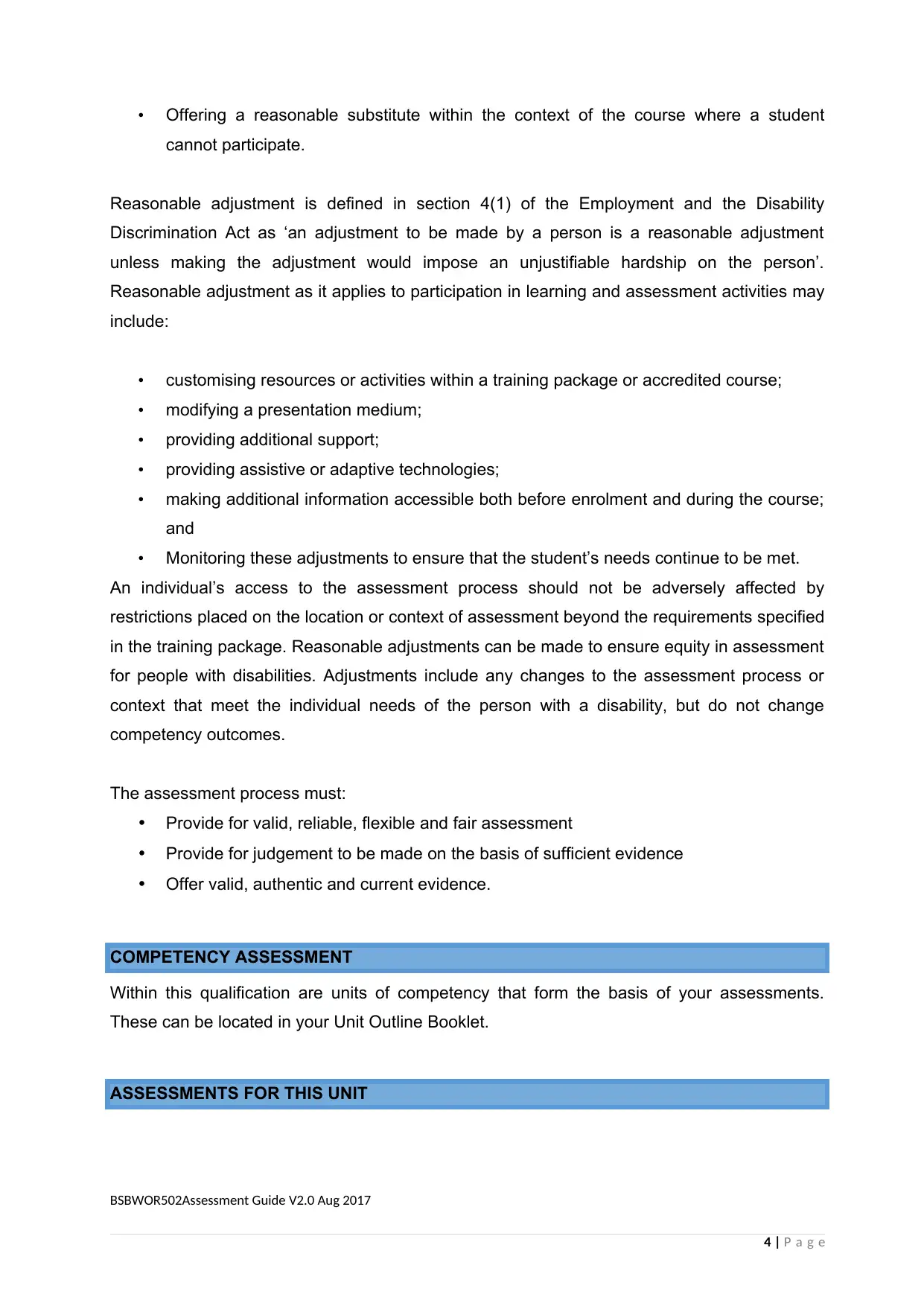
• Offering a reasonable substitute within the context of the course where a student
cannot participate.
Reasonable adjustment is defined in section 4(1) of the Employment and the Disability
Discrimination Act as ‘an adjustment to be made by a person is a reasonable adjustment
unless making the adjustment would impose an unjustifiable hardship on the person’.
Reasonable adjustment as it applies to participation in learning and assessment activities may
include:
• customising resources or activities within a training package or accredited course;
• modifying a presentation medium;
• providing additional support;
• providing assistive or adaptive technologies;
• making additional information accessible both before enrolment and during the course;
and
• Monitoring these adjustments to ensure that the student’s needs continue to be met.
An individual’s access to the assessment process should not be adversely affected by
restrictions placed on the location or context of assessment beyond the requirements specified
in the training package. Reasonable adjustments can be made to ensure equity in assessment
for people with disabilities. Adjustments include any changes to the assessment process or
context that meet the individual needs of the person with a disability, but do not change
competency outcomes.
The assessment process must:
Provide for valid, reliable, flexible and fair assessment
Provide for judgement to be made on the basis of sufficient evidence
Offer valid, authentic and current evidence.
COMPETENCY ASSESSMENT
Within this qualification are units of competency that form the basis of your assessments.
These can be located in your Unit Outline Booklet.
ASSESSMENTS FOR THIS UNIT
BSBWOR502Assessment Guide V2.0 Aug 2017
4 | P a g e
cannot participate.
Reasonable adjustment is defined in section 4(1) of the Employment and the Disability
Discrimination Act as ‘an adjustment to be made by a person is a reasonable adjustment
unless making the adjustment would impose an unjustifiable hardship on the person’.
Reasonable adjustment as it applies to participation in learning and assessment activities may
include:
• customising resources or activities within a training package or accredited course;
• modifying a presentation medium;
• providing additional support;
• providing assistive or adaptive technologies;
• making additional information accessible both before enrolment and during the course;
and
• Monitoring these adjustments to ensure that the student’s needs continue to be met.
An individual’s access to the assessment process should not be adversely affected by
restrictions placed on the location or context of assessment beyond the requirements specified
in the training package. Reasonable adjustments can be made to ensure equity in assessment
for people with disabilities. Adjustments include any changes to the assessment process or
context that meet the individual needs of the person with a disability, but do not change
competency outcomes.
The assessment process must:
Provide for valid, reliable, flexible and fair assessment
Provide for judgement to be made on the basis of sufficient evidence
Offer valid, authentic and current evidence.
COMPETENCY ASSESSMENT
Within this qualification are units of competency that form the basis of your assessments.
These can be located in your Unit Outline Booklet.
ASSESSMENTS FOR THIS UNIT
BSBWOR502Assessment Guide V2.0 Aug 2017
4 | P a g e
Paraphrase This Document
Need a fresh take? Get an instant paraphrase of this document with our AI Paraphraser
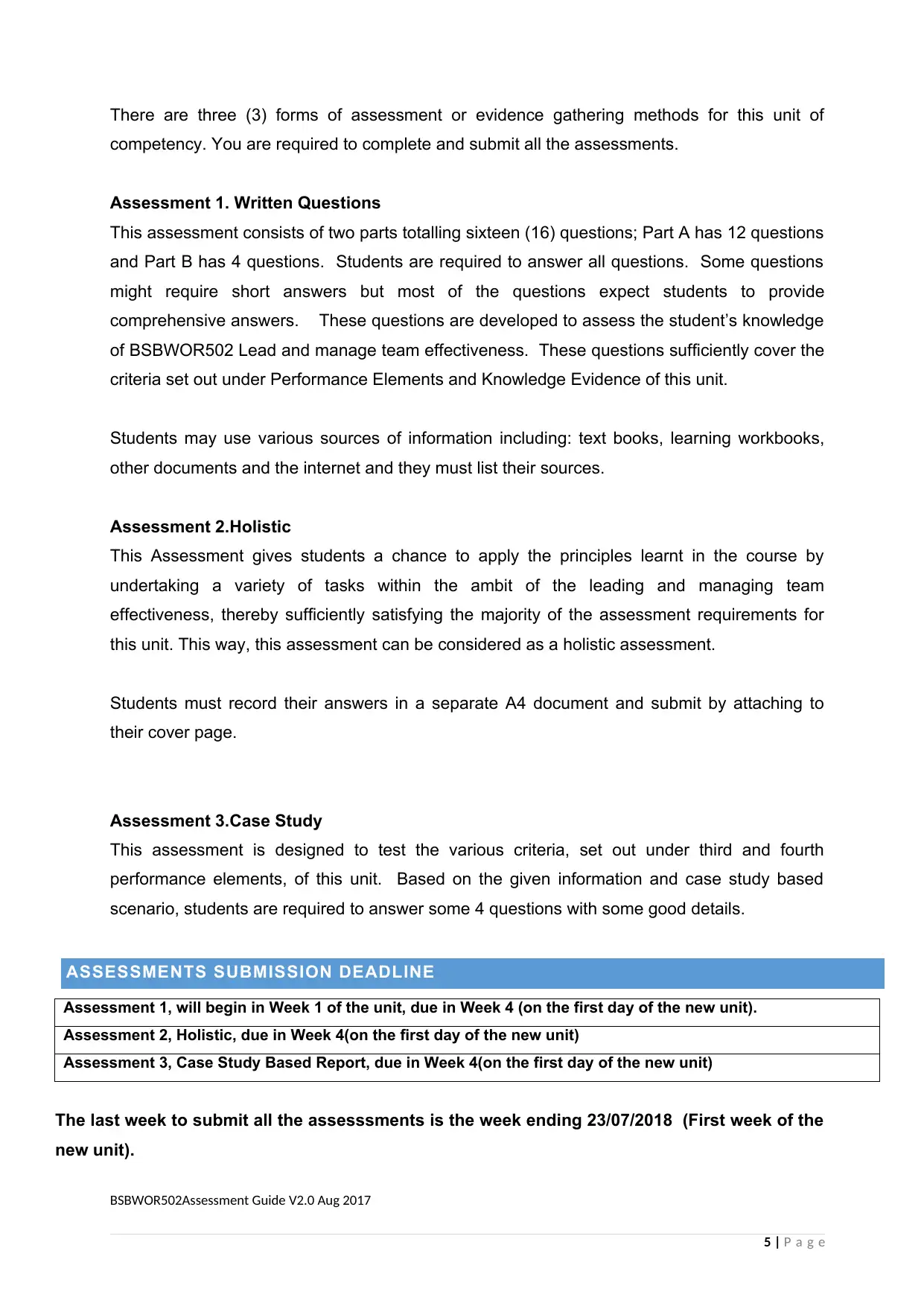
There are three (3) forms of assessment or evidence gathering methods for this unit of
competency. You are required to complete and submit all the assessments.
Assessment 1. Written Questions
This assessment consists of two parts totalling sixteen (16) questions; Part A has 12 questions
and Part B has 4 questions. Students are required to answer all questions. Some questions
might require short answers but most of the questions expect students to provide
comprehensive answers. These questions are developed to assess the student’s knowledge
of BSBWOR502 Lead and manage team effectiveness. These questions sufficiently cover the
criteria set out under Performance Elements and Knowledge Evidence of this unit.
Students may use various sources of information including: text books, learning workbooks,
other documents and the internet and they must list their sources.
Assessment 2.Holistic
This Assessment gives students a chance to apply the principles learnt in the course by
undertaking a variety of tasks within the ambit of the leading and managing team
effectiveness, thereby sufficiently satisfying the majority of the assessment requirements for
this unit. This way, this assessment can be considered as a holistic assessment.
Students must record their answers in a separate A4 document and submit by attaching to
their cover page.
Assessment 3.Case Study
This assessment is designed to test the various criteria, set out under third and fourth
performance elements, of this unit. Based on the given information and case study based
scenario, students are required to answer some 4 questions with some good details.
ASSESSMENTS SUBMISSION DEADLINE
Assessment 1, will begin in Week 1 of the unit, due in Week 4 (on the first day of the new unit).
Assessment 2, Holistic, due in Week 4(on the first day of the new unit)
Assessment 3, Case Study Based Report, due in Week 4(on the first day of the new unit)
The last week to submit all the assesssments is the week ending 23/07/2018 (First week of the
new unit).
BSBWOR502Assessment Guide V2.0 Aug 2017
5 | P a g e
competency. You are required to complete and submit all the assessments.
Assessment 1. Written Questions
This assessment consists of two parts totalling sixteen (16) questions; Part A has 12 questions
and Part B has 4 questions. Students are required to answer all questions. Some questions
might require short answers but most of the questions expect students to provide
comprehensive answers. These questions are developed to assess the student’s knowledge
of BSBWOR502 Lead and manage team effectiveness. These questions sufficiently cover the
criteria set out under Performance Elements and Knowledge Evidence of this unit.
Students may use various sources of information including: text books, learning workbooks,
other documents and the internet and they must list their sources.
Assessment 2.Holistic
This Assessment gives students a chance to apply the principles learnt in the course by
undertaking a variety of tasks within the ambit of the leading and managing team
effectiveness, thereby sufficiently satisfying the majority of the assessment requirements for
this unit. This way, this assessment can be considered as a holistic assessment.
Students must record their answers in a separate A4 document and submit by attaching to
their cover page.
Assessment 3.Case Study
This assessment is designed to test the various criteria, set out under third and fourth
performance elements, of this unit. Based on the given information and case study based
scenario, students are required to answer some 4 questions with some good details.
ASSESSMENTS SUBMISSION DEADLINE
Assessment 1, will begin in Week 1 of the unit, due in Week 4 (on the first day of the new unit).
Assessment 2, Holistic, due in Week 4(on the first day of the new unit)
Assessment 3, Case Study Based Report, due in Week 4(on the first day of the new unit)
The last week to submit all the assesssments is the week ending 23/07/2018 (First week of the
new unit).
BSBWOR502Assessment Guide V2.0 Aug 2017
5 | P a g e
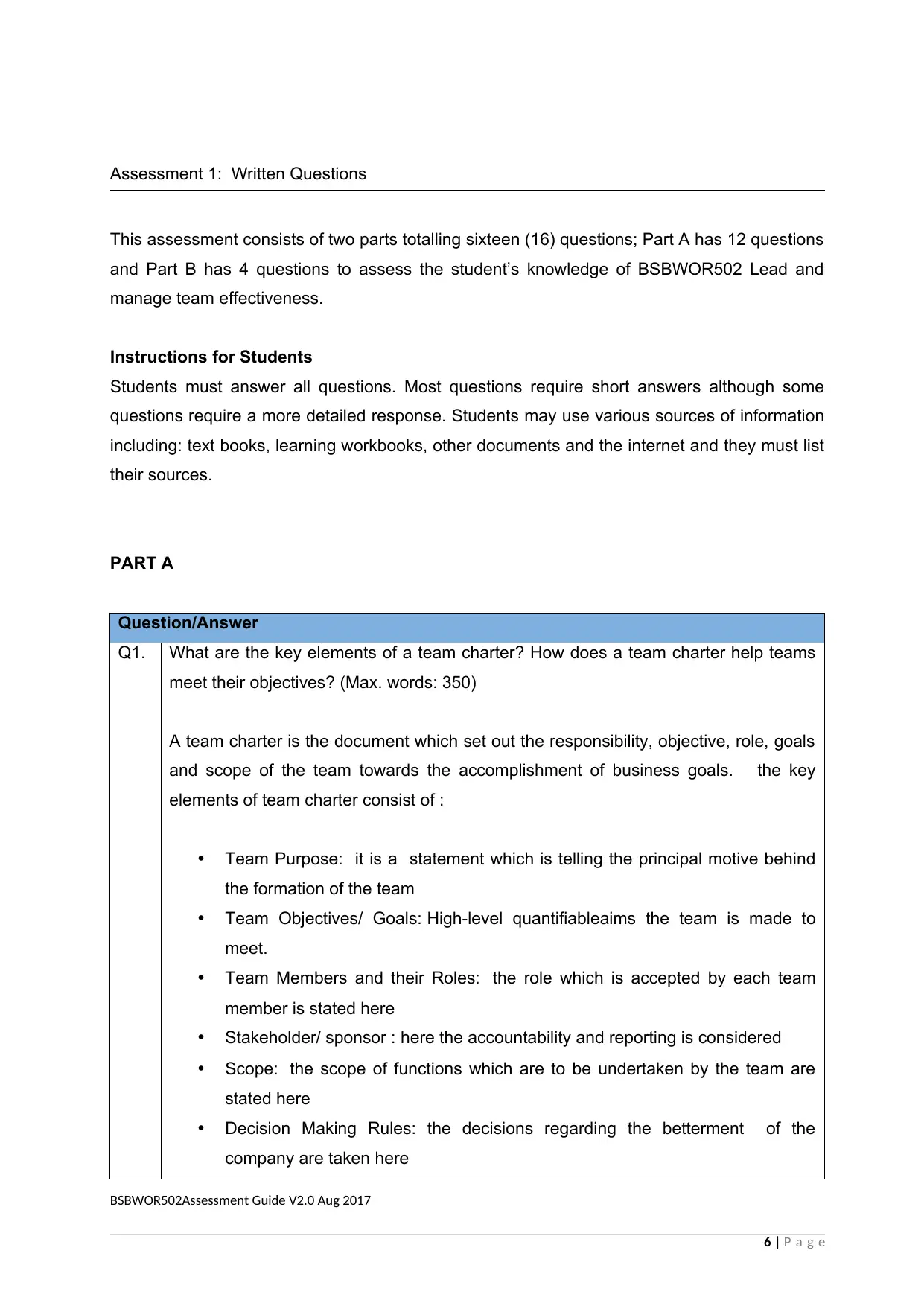
Assessment 1: Written Questions
This assessment consists of two parts totalling sixteen (16) questions; Part A has 12 questions
and Part B has 4 questions to assess the student’s knowledge of BSBWOR502 Lead and
manage team effectiveness.
Instructions for Students
Students must answer all questions. Most questions require short answers although some
questions require a more detailed response. Students may use various sources of information
including: text books, learning workbooks, other documents and the internet and they must list
their sources.
PART A
BSBWOR502Assessment Guide V2.0 Aug 2017
6 | P a g e
Question/Answer
Q1. What are the key elements of a team charter? How does a team charter help teams
meet their objectives? (Max. words: 350)
A team charter is the document which set out the responsibility, objective, role, goals
and scope of the team towards the accomplishment of business goals. the key
elements of team charter consist of :
Team Purpose: it is a statement which is telling the principal motive behind
the formation of the team
Team Objectives/ Goals: High-level quantifiableaims the team is made to
meet.
Team Members and their Roles: the role which is accepted by each team
member is stated here
Stakeholder/ sponsor : here the accountability and reporting is considered
Scope: the scope of functions which are to be undertaken by the team are
stated here
Decision Making Rules: the decisions regarding the betterment of the
company are taken here
This assessment consists of two parts totalling sixteen (16) questions; Part A has 12 questions
and Part B has 4 questions to assess the student’s knowledge of BSBWOR502 Lead and
manage team effectiveness.
Instructions for Students
Students must answer all questions. Most questions require short answers although some
questions require a more detailed response. Students may use various sources of information
including: text books, learning workbooks, other documents and the internet and they must list
their sources.
PART A
BSBWOR502Assessment Guide V2.0 Aug 2017
6 | P a g e
Question/Answer
Q1. What are the key elements of a team charter? How does a team charter help teams
meet their objectives? (Max. words: 350)
A team charter is the document which set out the responsibility, objective, role, goals
and scope of the team towards the accomplishment of business goals. the key
elements of team charter consist of :
Team Purpose: it is a statement which is telling the principal motive behind
the formation of the team
Team Objectives/ Goals: High-level quantifiableaims the team is made to
meet.
Team Members and their Roles: the role which is accepted by each team
member is stated here
Stakeholder/ sponsor : here the accountability and reporting is considered
Scope: the scope of functions which are to be undertaken by the team are
stated here
Decision Making Rules: the decisions regarding the betterment of the
company are taken here
⊘ This is a preview!⊘
Do you want full access?
Subscribe today to unlock all pages.

Trusted by 1+ million students worldwide
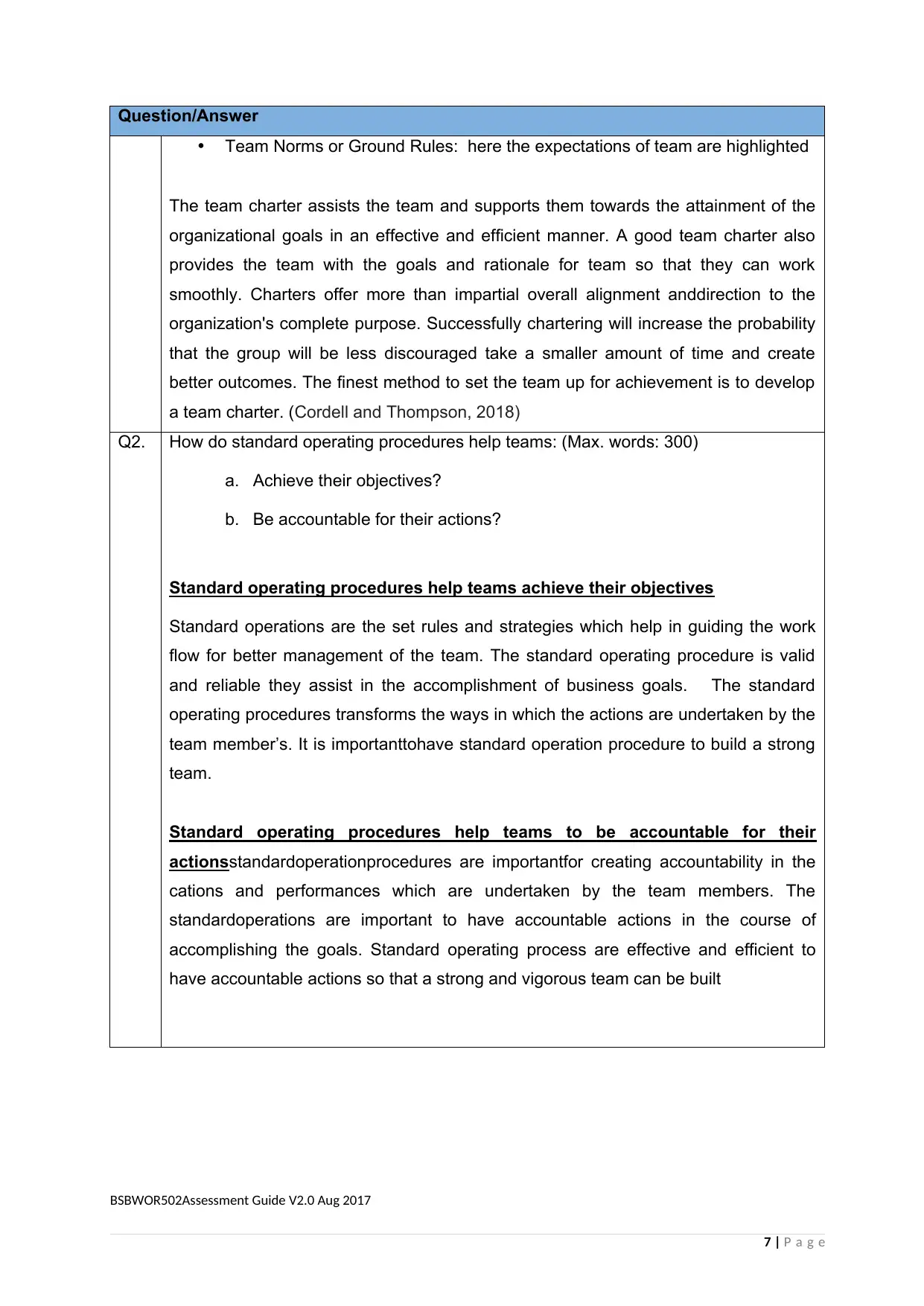
BSBWOR502Assessment Guide V2.0 Aug 2017
7 | P a g e
Question/Answer
Team Norms or Ground Rules: here the expectations of team are highlighted
The team charter assists the team and supports them towards the attainment of the
organizational goals in an effective and efficient manner. A good team charter also
provides the team with the goals and rationale for team so that they can work
smoothly. Charters offer more than impartial overall alignment anddirection to the
organization's complete purpose. Successfully chartering will increase the probability
that the group will be less discouraged take a smaller amount of time and create
better outcomes. The finest method to set the team up for achievement is to develop
a team charter. (Cordell and Thompson, 2018)
Q2. How do standard operating procedures help teams: (Max. words: 300)
a. Achieve their objectives?
b. Be accountable for their actions?
Standard operating procedures help teams achieve their objectives
Standard operations are the set rules and strategies which help in guiding the work
flow for better management of the team. The standard operating procedure is valid
and reliable they assist in the accomplishment of business goals. The standard
operating procedures transforms the ways in which the actions are undertaken by the
team member’s. It is importanttohave standard operation procedure to build a strong
team.
Standard operating procedures help teams to be accountable for their
actionsstandardoperationprocedures are importantfor creating accountability in the
cations and performances which are undertaken by the team members. The
standardoperations are important to have accountable actions in the course of
accomplishing the goals. Standard operating process are effective and efficient to
have accountable actions so that a strong and vigorous team can be built
7 | P a g e
Question/Answer
Team Norms or Ground Rules: here the expectations of team are highlighted
The team charter assists the team and supports them towards the attainment of the
organizational goals in an effective and efficient manner. A good team charter also
provides the team with the goals and rationale for team so that they can work
smoothly. Charters offer more than impartial overall alignment anddirection to the
organization's complete purpose. Successfully chartering will increase the probability
that the group will be less discouraged take a smaller amount of time and create
better outcomes. The finest method to set the team up for achievement is to develop
a team charter. (Cordell and Thompson, 2018)
Q2. How do standard operating procedures help teams: (Max. words: 300)
a. Achieve their objectives?
b. Be accountable for their actions?
Standard operating procedures help teams achieve their objectives
Standard operations are the set rules and strategies which help in guiding the work
flow for better management of the team. The standard operating procedure is valid
and reliable they assist in the accomplishment of business goals. The standard
operating procedures transforms the ways in which the actions are undertaken by the
team member’s. It is importanttohave standard operation procedure to build a strong
team.
Standard operating procedures help teams to be accountable for their
actionsstandardoperationprocedures are importantfor creating accountability in the
cations and performances which are undertaken by the team members. The
standardoperations are important to have accountable actions in the course of
accomplishing the goals. Standard operating process are effective and efficient to
have accountable actions so that a strong and vigorous team can be built
Paraphrase This Document
Need a fresh take? Get an instant paraphrase of this document with our AI Paraphraser

BSBWOR502Assessment Guide V2.0 Aug 2017
8 | P a g e
Question/Answer
Q3. What is positive coaching? How does this benefit teams and individuals? (Max.
words: 350)
Positive Coaching
Positive Coaching is all about allowing and teaching the athletes to prepare better,
accomplish more, perform better to understandindividual excellence, and to be,
happier, prouder , more fulfilled and happier for their efforts ,investment and
areencouraged to come again and do more. The positive coaching helps in
transforming the weakness of an individual into strengths (Dave, et. al., 2017)
The benefit of positive coaching to team:
coaching is important to maintain a good communication in the team
coachinghelps in the attainment of gaols and standardswhich are set by the
team
coaching transforms the characters and interest of the team to be more
competent
The benefit of positive coaching to individuals:
Increased engagement: a complete participation by the team members
results in better performance
Profounder level of learning: coaching results not only in improving skills but
also provides for deeper learnings. With the help of coaching an individual can
learn more
Improve personal skills: coaching helps an individual to enhance their existing
skills.
Construct an individual awareness: the coach is required to develop new
ways for improving the attentiveness of an individual
8 | P a g e
Question/Answer
Q3. What is positive coaching? How does this benefit teams and individuals? (Max.
words: 350)
Positive Coaching
Positive Coaching is all about allowing and teaching the athletes to prepare better,
accomplish more, perform better to understandindividual excellence, and to be,
happier, prouder , more fulfilled and happier for their efforts ,investment and
areencouraged to come again and do more. The positive coaching helps in
transforming the weakness of an individual into strengths (Dave, et. al., 2017)
The benefit of positive coaching to team:
coaching is important to maintain a good communication in the team
coachinghelps in the attainment of gaols and standardswhich are set by the
team
coaching transforms the characters and interest of the team to be more
competent
The benefit of positive coaching to individuals:
Increased engagement: a complete participation by the team members
results in better performance
Profounder level of learning: coaching results not only in improving skills but
also provides for deeper learnings. With the help of coaching an individual can
learn more
Improve personal skills: coaching helps an individual to enhance their existing
skills.
Construct an individual awareness: the coach is required to develop new
ways for improving the attentiveness of an individual
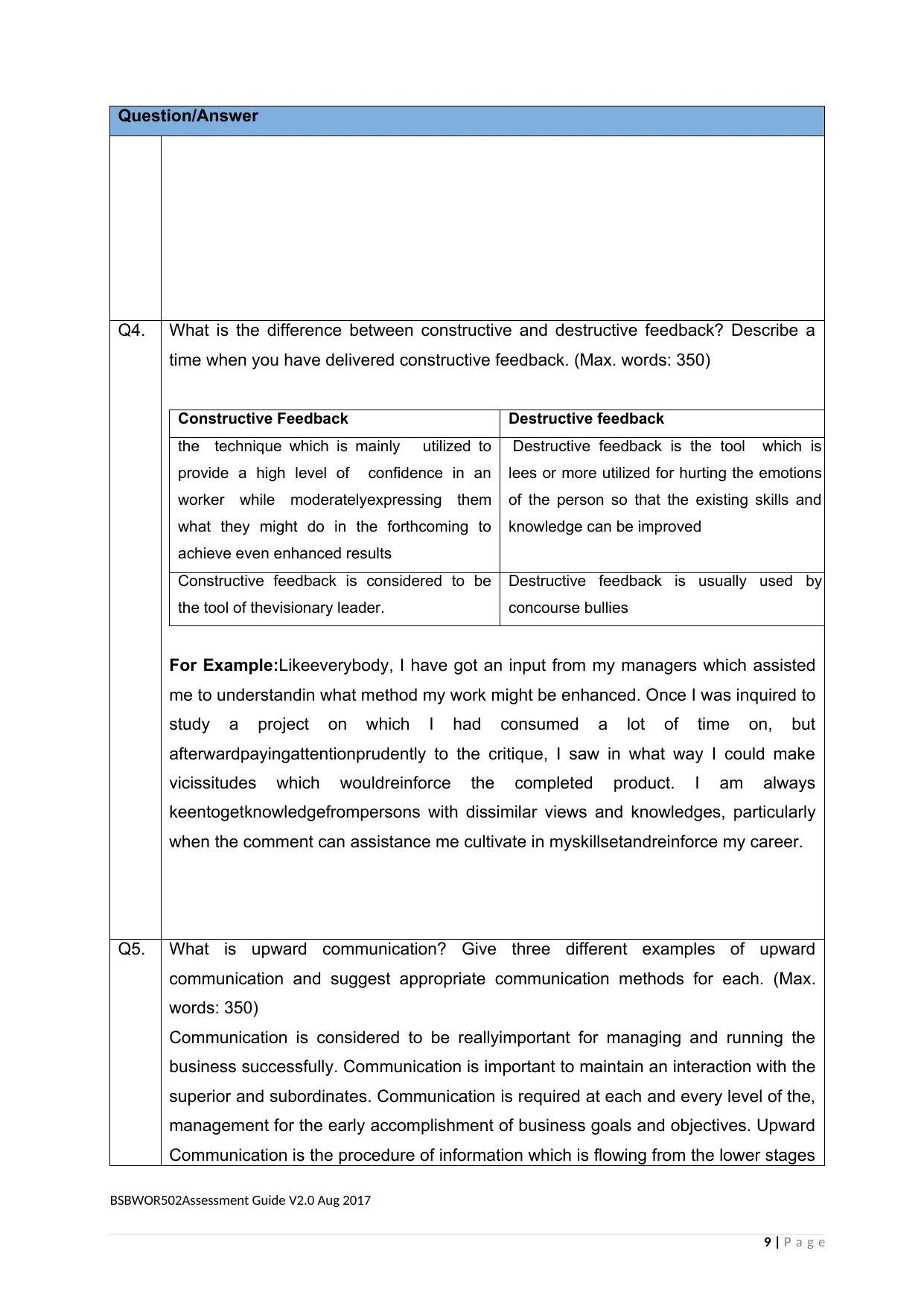
BSBWOR502Assessment Guide V2.0 Aug 2017
9 | P a g e
Question/Answer
Q4. What is the difference between constructive and destructive feedback? Describe a
time when you have delivered constructive feedback. (Max. words: 350)
Constructive Feedback Destructive feedback
the technique which is mainly utilized to
provide a high level of confidence in an
worker while moderatelyexpressing them
what they might do in the forthcoming to
achieve even enhanced results
Destructive feedback is the tool which is
lees or more utilized for hurting the emotions
of the person so that the existing skills and
knowledge can be improved
Constructive feedback is considered to be
the tool of thevisionary leader.
Destructive feedback is usually used by
concourse bullies
For Example:Likeeverybody, I have got an input from my managers which assisted
me to understandin what method my work might be enhanced. Once I was inquired to
study a project on which I had consumed a lot of time on, but
afterwardpayingattentionprudently to the critique, I saw in what way I could make
vicissitudes which wouldreinforce the completed product. I am always
keentogetknowledgefrompersons with dissimilar views and knowledges, particularly
when the comment can assistance me cultivate in myskillsetandreinforce my career.
Q5. What is upward communication? Give three different examples of upward
communication and suggest appropriate communication methods for each. (Max.
words: 350)
Communication is considered to be reallyimportant for managing and running the
business successfully. Communication is important to maintain an interaction with the
superior and subordinates. Communication is required at each and every level of the,
management for the early accomplishment of business goals and objectives. Upward
Communication is the procedure of information which is flowing from the lower stages
9 | P a g e
Question/Answer
Q4. What is the difference between constructive and destructive feedback? Describe a
time when you have delivered constructive feedback. (Max. words: 350)
Constructive Feedback Destructive feedback
the technique which is mainly utilized to
provide a high level of confidence in an
worker while moderatelyexpressing them
what they might do in the forthcoming to
achieve even enhanced results
Destructive feedback is the tool which is
lees or more utilized for hurting the emotions
of the person so that the existing skills and
knowledge can be improved
Constructive feedback is considered to be
the tool of thevisionary leader.
Destructive feedback is usually used by
concourse bullies
For Example:Likeeverybody, I have got an input from my managers which assisted
me to understandin what method my work might be enhanced. Once I was inquired to
study a project on which I had consumed a lot of time on, but
afterwardpayingattentionprudently to the critique, I saw in what way I could make
vicissitudes which wouldreinforce the completed product. I am always
keentogetknowledgefrompersons with dissimilar views and knowledges, particularly
when the comment can assistance me cultivate in myskillsetandreinforce my career.
Q5. What is upward communication? Give three different examples of upward
communication and suggest appropriate communication methods for each. (Max.
words: 350)
Communication is considered to be reallyimportant for managing and running the
business successfully. Communication is important to maintain an interaction with the
superior and subordinates. Communication is required at each and every level of the,
management for the early accomplishment of business goals and objectives. Upward
Communication is the procedure of information which is flowing from the lower stages
⊘ This is a preview!⊘
Do you want full access?
Subscribe today to unlock all pages.

Trusted by 1+ million students worldwide
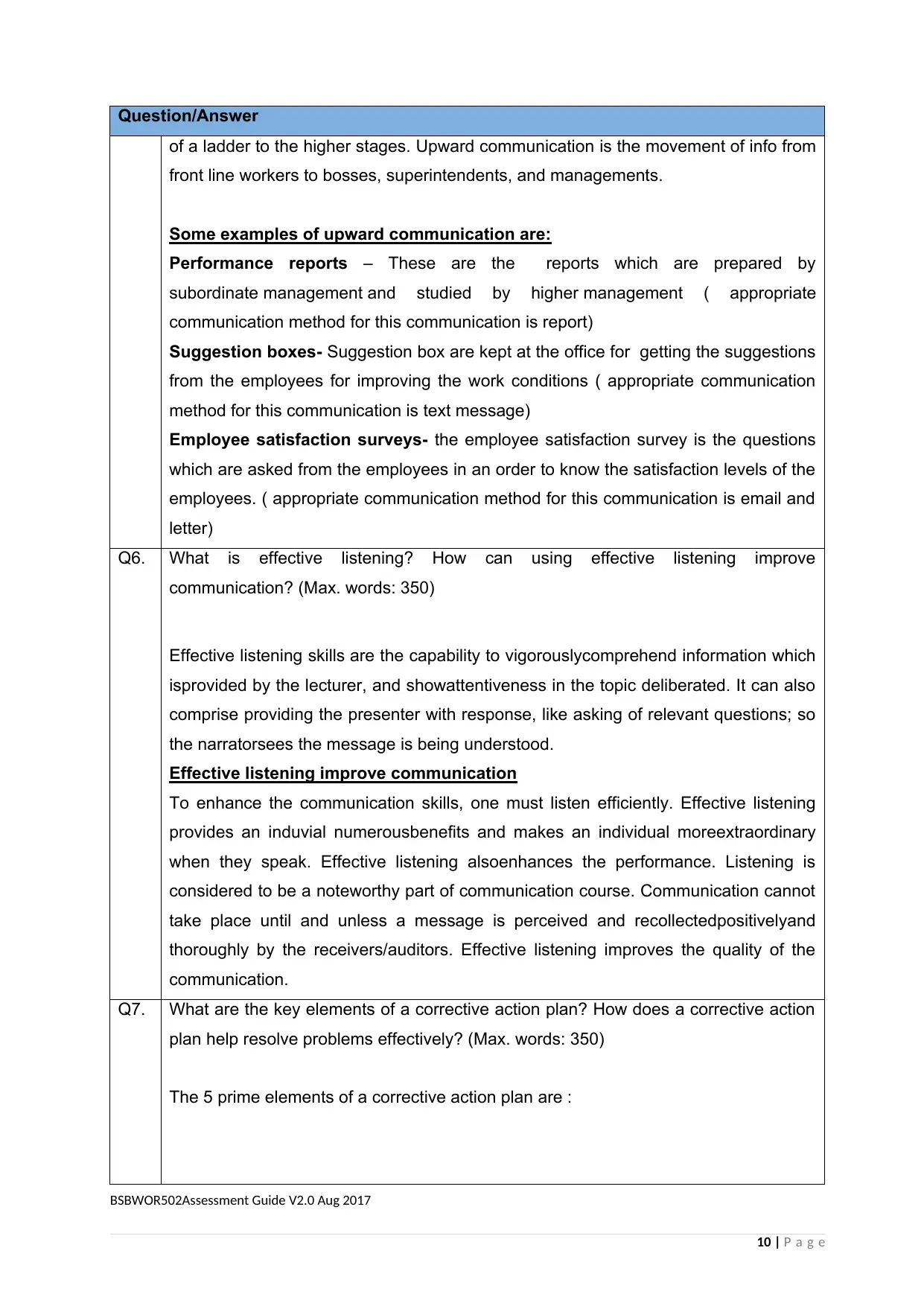
BSBWOR502Assessment Guide V2.0 Aug 2017
10 | P a g e
Question/Answer
of a ladder to the higher stages. Upward communication is the movement of info from
front line workers to bosses, superintendents, and managements.
Some examples of upward communication are:
Performance reports – These are the reports which are prepared by
subordinate management and studied by higher management ( appropriate
communication method for this communication is report)
Suggestion boxes- Suggestion box are kept at the office for getting the suggestions
from the employees for improving the work conditions ( appropriate communication
method for this communication is text message)
Employee satisfaction surveys- the employee satisfaction survey is the questions
which are asked from the employees in an order to know the satisfaction levels of the
employees. ( appropriate communication method for this communication is email and
letter)
Q6. What is effective listening? How can using effective listening improve
communication? (Max. words: 350)
Effective listening skills are the capability to vigorouslycomprehend information which
isprovided by the lecturer, and showattentiveness in the topic deliberated. It can also
comprise providing the presenter with response, like asking of relevant questions; so
the narratorsees the message is being understood.
Effective listening improve communication
To enhance the communication skills, one must listen efficiently. Effective listening
provides an induvial numerousbenefits and makes an individual moreextraordinary
when they speak. Effective listening alsoenhances the performance. Listening is
considered to be a noteworthy part of communication course. Communication cannot
take place until and unless a message is perceived and recollectedpositivelyand
thoroughly by the receivers/auditors. Effective listening improves the quality of the
communication.
Q7. What are the key elements of a corrective action plan? How does a corrective action
plan help resolve problems effectively? (Max. words: 350)
The 5 prime elements of a corrective action plan are :
10 | P a g e
Question/Answer
of a ladder to the higher stages. Upward communication is the movement of info from
front line workers to bosses, superintendents, and managements.
Some examples of upward communication are:
Performance reports – These are the reports which are prepared by
subordinate management and studied by higher management ( appropriate
communication method for this communication is report)
Suggestion boxes- Suggestion box are kept at the office for getting the suggestions
from the employees for improving the work conditions ( appropriate communication
method for this communication is text message)
Employee satisfaction surveys- the employee satisfaction survey is the questions
which are asked from the employees in an order to know the satisfaction levels of the
employees. ( appropriate communication method for this communication is email and
letter)
Q6. What is effective listening? How can using effective listening improve
communication? (Max. words: 350)
Effective listening skills are the capability to vigorouslycomprehend information which
isprovided by the lecturer, and showattentiveness in the topic deliberated. It can also
comprise providing the presenter with response, like asking of relevant questions; so
the narratorsees the message is being understood.
Effective listening improve communication
To enhance the communication skills, one must listen efficiently. Effective listening
provides an induvial numerousbenefits and makes an individual moreextraordinary
when they speak. Effective listening alsoenhances the performance. Listening is
considered to be a noteworthy part of communication course. Communication cannot
take place until and unless a message is perceived and recollectedpositivelyand
thoroughly by the receivers/auditors. Effective listening improves the quality of the
communication.
Q7. What are the key elements of a corrective action plan? How does a corrective action
plan help resolve problems effectively? (Max. words: 350)
The 5 prime elements of a corrective action plan are :
Paraphrase This Document
Need a fresh take? Get an instant paraphrase of this document with our AI Paraphraser
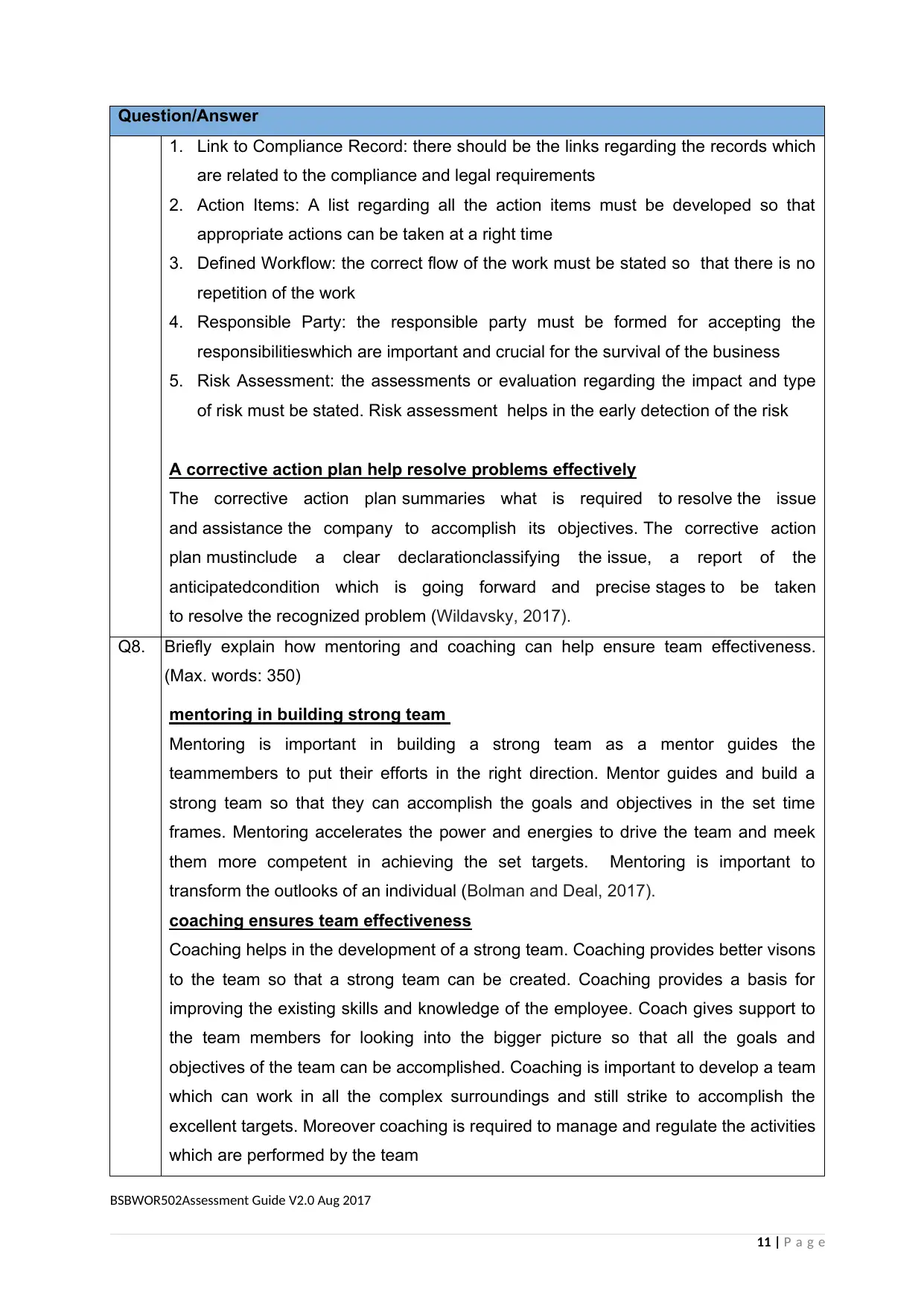
BSBWOR502Assessment Guide V2.0 Aug 2017
11 | P a g e
Question/Answer
1. Link to Compliance Record: there should be the links regarding the records which
are related to the compliance and legal requirements
2. Action Items: A list regarding all the action items must be developed so that
appropriate actions can be taken at a right time
3. Defined Workflow: the correct flow of the work must be stated so that there is no
repetition of the work
4. Responsible Party: the responsible party must be formed for accepting the
responsibilitieswhich are important and crucial for the survival of the business
5. Risk Assessment: the assessments or evaluation regarding the impact and type
of risk must be stated. Risk assessment helps in the early detection of the risk
A corrective action plan help resolve problems effectively
The corrective action plan summaries what is required to resolve the issue
and assistance the company to accomplish its objectives. The corrective action
plan mustinclude a clear declarationclassifying the issue, a report of the
anticipatedcondition which is going forward and precise stages to be taken
to resolve the recognized problem (Wildavsky, 2017).
Q8. Briefly explain how mentoring and coaching can help ensure team effectiveness.
(Max. words: 350)
mentoring in building strong team
Mentoring is important in building a strong team as a mentor guides the
teammembers to put their efforts in the right direction. Mentor guides and build a
strong team so that they can accomplish the goals and objectives in the set time
frames. Mentoring accelerates the power and energies to drive the team and meek
them more competent in achieving the set targets. Mentoring is important to
transform the outlooks of an individual (Bolman and Deal, 2017).
coaching ensures team effectiveness
Coaching helps in the development of a strong team. Coaching provides better visons
to the team so that a strong team can be created. Coaching provides a basis for
improving the existing skills and knowledge of the employee. Coach gives support to
the team members for looking into the bigger picture so that all the goals and
objectives of the team can be accomplished. Coaching is important to develop a team
which can work in all the complex surroundings and still strike to accomplish the
excellent targets. Moreover coaching is required to manage and regulate the activities
which are performed by the team
11 | P a g e
Question/Answer
1. Link to Compliance Record: there should be the links regarding the records which
are related to the compliance and legal requirements
2. Action Items: A list regarding all the action items must be developed so that
appropriate actions can be taken at a right time
3. Defined Workflow: the correct flow of the work must be stated so that there is no
repetition of the work
4. Responsible Party: the responsible party must be formed for accepting the
responsibilitieswhich are important and crucial for the survival of the business
5. Risk Assessment: the assessments or evaluation regarding the impact and type
of risk must be stated. Risk assessment helps in the early detection of the risk
A corrective action plan help resolve problems effectively
The corrective action plan summaries what is required to resolve the issue
and assistance the company to accomplish its objectives. The corrective action
plan mustinclude a clear declarationclassifying the issue, a report of the
anticipatedcondition which is going forward and precise stages to be taken
to resolve the recognized problem (Wildavsky, 2017).
Q8. Briefly explain how mentoring and coaching can help ensure team effectiveness.
(Max. words: 350)
mentoring in building strong team
Mentoring is important in building a strong team as a mentor guides the
teammembers to put their efforts in the right direction. Mentor guides and build a
strong team so that they can accomplish the goals and objectives in the set time
frames. Mentoring accelerates the power and energies to drive the team and meek
them more competent in achieving the set targets. Mentoring is important to
transform the outlooks of an individual (Bolman and Deal, 2017).
coaching ensures team effectiveness
Coaching helps in the development of a strong team. Coaching provides better visons
to the team so that a strong team can be created. Coaching provides a basis for
improving the existing skills and knowledge of the employee. Coach gives support to
the team members for looking into the bigger picture so that all the goals and
objectives of the team can be accomplished. Coaching is important to develop a team
which can work in all the complex surroundings and still strike to accomplish the
excellent targets. Moreover coaching is required to manage and regulate the activities
which are performed by the team
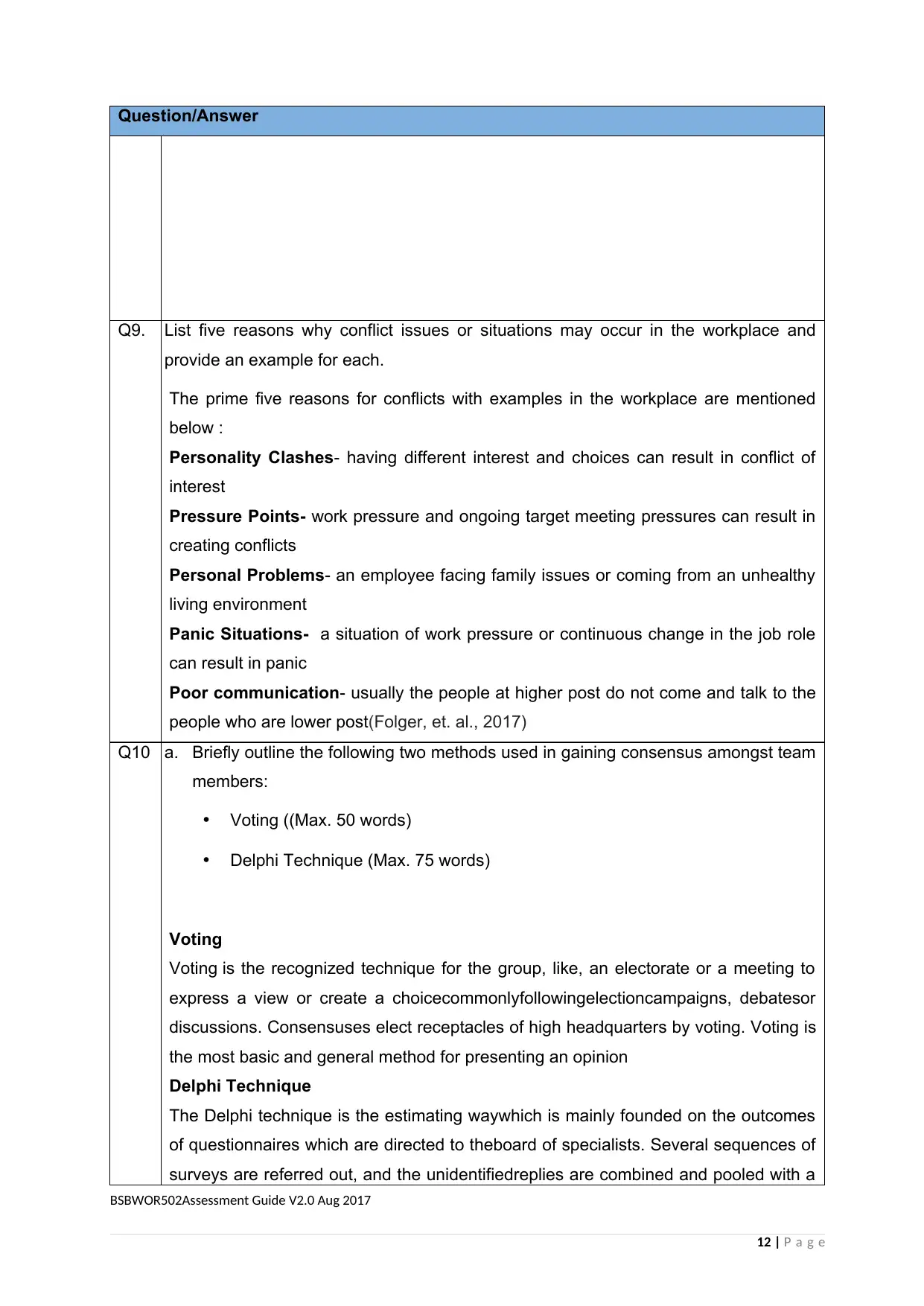
BSBWOR502Assessment Guide V2.0 Aug 2017
12 | P a g e
Question/Answer
Q9. List five reasons why conflict issues or situations may occur in the workplace and
provide an example for each.
The prime five reasons for conflicts with examples in the workplace are mentioned
below :
Personality Clashes- having different interest and choices can result in conflict of
interest
Pressure Points- work pressure and ongoing target meeting pressures can result in
creating conflicts
Personal Problems- an employee facing family issues or coming from an unhealthy
living environment
Panic Situations- a situation of work pressure or continuous change in the job role
can result in panic
Poor communication- usually the people at higher post do not come and talk to the
people who are lower post(Folger, et. al., 2017)
Q10 a. Briefly outline the following two methods used in gaining consensus amongst team
members:
Voting ((Max. 50 words)
Delphi Technique (Max. 75 words)
Voting
Voting is the recognized technique for the group, like, an electorate or a meeting to
express a view or create a choicecommonlyfollowingelectioncampaigns, debatesor
discussions. Consensuses elect receptacles of high headquarters by voting. Voting is
the most basic and general method for presenting an opinion
Delphi Technique
The Delphi technique is the estimating waywhich is mainly founded on the outcomes
of questionnaires which are directed to theboard of specialists. Several sequences of
surveys are referred out, and the unidentifiedreplies are combined and pooled with a
12 | P a g e
Question/Answer
Q9. List five reasons why conflict issues or situations may occur in the workplace and
provide an example for each.
The prime five reasons for conflicts with examples in the workplace are mentioned
below :
Personality Clashes- having different interest and choices can result in conflict of
interest
Pressure Points- work pressure and ongoing target meeting pressures can result in
creating conflicts
Personal Problems- an employee facing family issues or coming from an unhealthy
living environment
Panic Situations- a situation of work pressure or continuous change in the job role
can result in panic
Poor communication- usually the people at higher post do not come and talk to the
people who are lower post(Folger, et. al., 2017)
Q10 a. Briefly outline the following two methods used in gaining consensus amongst team
members:
Voting ((Max. 50 words)
Delphi Technique (Max. 75 words)
Voting
Voting is the recognized technique for the group, like, an electorate or a meeting to
express a view or create a choicecommonlyfollowingelectioncampaigns, debatesor
discussions. Consensuses elect receptacles of high headquarters by voting. Voting is
the most basic and general method for presenting an opinion
Delphi Technique
The Delphi technique is the estimating waywhich is mainly founded on the outcomes
of questionnaires which are directed to theboard of specialists. Several sequences of
surveys are referred out, and the unidentifiedreplies are combined and pooled with a
⊘ This is a preview!⊘
Do you want full access?
Subscribe today to unlock all pages.

Trusted by 1+ million students worldwide
1 out of 49
Related Documents
Your All-in-One AI-Powered Toolkit for Academic Success.
+13062052269
info@desklib.com
Available 24*7 on WhatsApp / Email
![[object Object]](/_next/static/media/star-bottom.7253800d.svg)
Unlock your academic potential
Copyright © 2020–2025 A2Z Services. All Rights Reserved. Developed and managed by ZUCOL.




